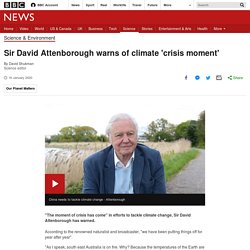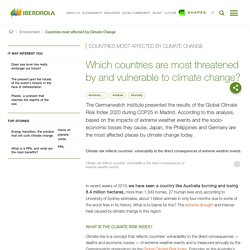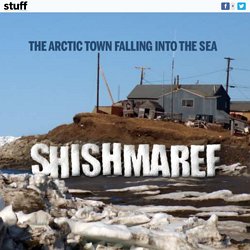

Global warming and the greenhouse effect. Earth’s atmosphere works something like a giant glass greenhouse.

As the sun’s rays enter our atmosphere, most continue right down to the planet’s surface. As they hit the soil and surface waters, those rays release much of their energy as heat. Some of the heat then radiates back out into space. However, certain gases in our atmosphere, such as carbon dioxide, methane and water vapor, work like a blanket to retain much of that heat. This helps to warm our atmosphere. Educators and Parents, Sign Up for The Cheat Sheet Weekly updates to help you use Science News for Students in the learning environment But there can be too much of a good thing. By examining air bubbles in ice cores taken from Antarctica, scientists can go back and calculate what the concentrations of carbon dioxide in the atmosphere have been throughout the last 650,000 years.
Causes. › en español Scientists attribute the global warming trend observed since the mid-20th century to the human expansion of the "greenhouse effect"1 — warming that results when the atmosphere traps heat radiating from Earth toward space.

Certain gases in the atmosphere block heat from escaping. Long-lived gases that remain semi-permanently in the atmosphere and do not respond physically or chemically to changes in temperature are described as "forcing" climate change. Gases, such as water vapor, which respond physically or chemically to changes in temperature are seen as "feedbacks. " Gases that contribute to the greenhouse effect include: Climate Change Basics. What is causing climate change? Causes and Effects of Climate Change.
What is climate change and how does it affect us? Cookies are small text files that can be used by websites to make a user's experience more efficient.

The law states that we can store cookies on your device if they are strictly necessary for the operation of this site. For all other types of cookies we need your permission. This site uses different types of cookies. Some cookies are placed by third party services that appear on our pages. Activity 43 9 (1) Climate change drove Australian wildfires to extremes. Attribution science: A field of research, largely used in climate studies.

It seeks to test whether — and by how much — climate change may be responsible for certain extreme weather events, such as droughts, extreme flooding, hurricanes, excessive heat or odd storm trajectories. average: (in science) A term for the arithmetic mean, which is the sum of a group of numbers that is then divided by the size of the group. climate: The weather conditions that typically exist in one area, in general, or over a long period. climate change: Long-term, significant change in the climate of Earth.
It can happen naturally or in response to human activities, including the burning of fossil fuels and clearing of forests. colleague: Someone who works with another; a co-worker or team member. computer model: A program that runs on a computer that creates a model, or simulation, of a real-world feature, phenomenon or event. factor: Something that plays a role in a particular condition or event; a contributor. Climate Change & Flooding. Sign Up to Receive Flooding Thought Leadership Climate change is increasing the risk of flooding in the US by rising sea levels, increasing extreme precipitation and total precipitation, intensifying storm precipitation, and increasing rates of snow and ice melt.

Worsening floods due to climate change are putting a growing number of inland and coastal communities at risk. This year, the spring flood season is overlapping with COVID-19, multiplying the threat to communities at risk of being displaced by flood disasters. How has climate change already worsened US flooding? What is flooding and why is it dangerous? A flood is an overflowing of water onto land that is normally dry, and a flash flood is when flooding occurs less than 6 hours after an extreme rainfall event. Sir David Attenborough warns of climate 'crisis moment' Media playback is unsupported on your device "The moment of crisis has come" in efforts to tackle climate change, Sir David Attenborough has warned.

According to the renowned naturalist and broadcaster, "we have been putting things off for year after year". "As I speak, south east Australia is on fire. Ranking 10 Countries most affected by Climate Change. 4.

Explainer: Desertification and the role of climate change. Desertification has been described as “the greatest environmental challenge of our time” and climate change is making it worse.

While the term may bring to mind the windswept sand dunes of the Sahara or the vast salt pans of the Kalahari, it’s an issue that reaches far beyond those living in and around the world’s deserts, threatening the food security and livelihoods of more than two billion people. The combined impact of climate change, land mismanagement and unsustainable freshwater use has seen the world’s water-scarce regions increasingly degraded. This leaves their soils less able to support crops, livestock and wildlife. Climate change: Hurricanes get stronger on land as world warms. Climate Change 101 with Bill Nye. Countdown: It's time. Let's turn the tide on climate. Shishmaref. Witnessing the frenzied activity of the spring hunt, it’s almost possible to forget Shishmaref has so little time left.

The villagers are racing to get enough seal meat while the ice holds out. Hunters blast on quad bikes down the only paved road, hurrying into the general store to pick up supplies - bullets, Marlboros, cases of Coke - to take with them on the ice. Bicycle gangs of kids tool along after them. “Hi,” says a passing boy, and I notice his smile is full of metal teeth that have replaced decaying ones. Climate Change Is Killing This Alaskan Village (HBO) Shishmaref, Alaska: Tragedy of a village built on ice. Their bodies are buried in the cemetery, I'm sure of it.

I've seen the obituaries. But neither man is dead. No one in Shishmaref dies, I'm told -- not really. It's about 9 a.m. as I trudge through the snow, past the cemetery and to a neighboring house. Climate and Frozen Ground. Figure 1. This building in Shishmaref used to be farther from the sea. Climate change is causing the shore to wash away. Eventually, this building will have to be moved, or it will collapse.
—Credit: Angela Alston. This is What Climate Change Looks Like in Alaska—Right Now. A sea wall protects the village of Kivalina from the battering waves of the Chukchi Sea. The village recently secured funding to build a new school at a future relocation site. In Utqiaġvik, Alaska, the northernmost community in the United States, last winter’s temperatures were so warm that algorithms in weather monitoring stations were flagging them as false. Alaska - Fourth National Climate Assessment. The influence of climate change on human health in Alaska can be traced to three sources: direct exposures, indirect effects, and social or psychological disruption.
Each of these will have different manifestations for Alaskans when compared to residents elsewhere in the United States. Direct Exposures In general, even with a warming climate, Alaska is not expected to experience the extremes of heat and humidity found at lower latitudes; however, rising temperatures do pose a risk. Air conditioning in homes is rare in Alaska, so relief is seldom available for at-risk persons to escape high temperatures or from smoke exposure due to wildfires, assuming proper filters are not installed.
Winter travel has long been a key feature of subsistence food gathering activities for rural Alaska communities. Regional releases alaska web version. What is causing climate change? - Committee on Climate Change. Geological records stretching back millions of years indicate a number of large variations in Earth’s past climate. These have been caused by many natural factors, including changes in the sun, volcanoes, Earth’s orbit and CO2 levels. However, comprehensive assessment by scientists shows that it is extremely likely that human activity has been the dominant cause of warming since the mid-20th Century. Greenhouse gas emissions.